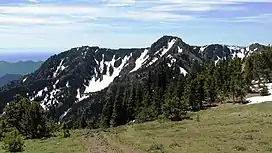Welch Peaks
Welch Peaks is a 6,110-foot (1,860-metre) elevation mountain in the eastern Olympic Mountains in Jefferson County of Washington state. It is set within Buckhorn Wilderness, on land managed by the Olympic National Forest. The nearest higher neighbor is Mount Townsend, 1.2 mi (1.9 km) to the north, and Mount Worthington rises 2.1 mi (3.4 km) to the southwest. Precipitation runoff from Welch Peaks drains into tributaries of the Big Quilcene River, and Silver Creek which is a tributary of the Dungeness River. Topographic relief is significant as the summit rises 3,100 feet (945 m) above Townsend Creek in approximately one mile. The mountain's name was officially adopted in 1963 by the U.S. Board on Geographic Names.[4]
| Welch Peaks | |
|---|---|
 North aspect, seen from Mt. Townsend trail | |
| Highest point | |
| Elevation | 6,110 ft (1,860 m)[1] |
| Prominence | 350 ft (110 m)[2] |
| Parent peak | Mount Townsend (6,243 ft)[3] |
| Isolation | 1.17 mi (1.88 km)[3] |
| Coordinates | 47°50′42″N 123°03′50″W[4] |
| Geography | |
 Welch Peaks Location of Welch Peaks in Washington  Welch Peaks Welch Peaks (the United States) | |
| Location | Buckhorn Wilderness Jefferson County, Washington, US |
| Parent range | Olympic Mountains |
| Topo map | USGS Mount Townsend |
| Geology | |
| Age of rock | Eocene |
| Climbing | |
| Easiest route | class 2 scrambling[3] |
Climate
Welch Peaks is in the marine west coast climate zone of western North America.[5] Most weather fronts originate in the Pacific Ocean, and travel northeast toward the Olympic Mountains. As fronts approach, they are forced upward by the peaks of the Olympic Range, causing them to drop their moisture in the form of rain or snowfall (Orographic lift). As a result, the Olympics experience high precipitation, especially during the winter months in the form of snowfall. During winter months, weather is usually cloudy, but, due to high pressure systems over the Pacific Ocean that intensify during summer months, there is often little or no cloud cover during the summer. Because of maritime influence, snow tends to be wet and heavy, resulting in avalanche danger.
Geology
The Olympic Mountains are composed of obducted clastic wedge material and oceanic crust, primarily Eocene sandstone, turbidite, and basaltic oceanic crust.[6] The mountains were sculpted during the Pleistocene era by erosion and glaciers advancing and retreating multiple times.
Gallery
References
- Olympic Mountain Rescue, Olympic Mountains: A Climbing Guide, 4th Edition, 2006, Mountaineers Books, ISBN 9780898862065, page 136.
- "Welch Peaks". Peakbagger.com.
- "Welch Peaks – 6,110' WA". listsofjohn.com. Retrieved January 15, 2022.
- "Welch Peaks". Geographic Names Information System. United States Geological Survey, United States Department of the Interior. Retrieved January 15, 2022.
- Peel, M. C.; Finlayson, B. L.; McMahon, T. A. (2007). "Updated world map of the Köppen−Geiger climate classification". Hydrol. Earth Syst. Sci. 11. ISSN 1027-5606.
- Alt, D.D.; Hyndman, D.W. (1984). Roadside Geology of Washington. pp. 249–259. ISBN 0-87842-160-2.
External links
- Weather forecast: Welch Peaks


.jpg.webp)

